Experimental and Numerical Analyses on the Frost Heave Deformation of Reclaimed Gravel from a Tunnel Excavation as a Structural Fill in Cold Mountainous Regions
Abstract
:1. Introduction
2. Climatic and Geological Conditions of the Study Area
2.1. Climatic Conditions
2.2. Geological Conditions
3. Materials and Methods
3.1. Laboratory Test
3.1.1. Basic Physical, Mechanical, and Thermal Properties of Soils
3.1.2. Laboratory Frost-Heave Experiment
3.1.3. Frost Susceptibility of Silty Clay and Gravel Soils
3.2. Field Trial—Field Layout and Instrumentation
3.3. Numerical Simulation
3.3.1. Frost-Heave Model
3.3.2. Computational Model and Soil Parameters
4. Results and Analysis
4.1. Deformations of Field Investgation
4.1.1. Deformations
4.1.2. Differential Frost-Heave Deformations between the Two Sections
4.1.3. Performance of the TDH after It Enters into Service
4.2. Results and Analyses of Numerical Simulation
4.2.1. Computational Model Validation
4.2.2. Effect of Fill Replacement Thickness on Ice-Lens Formation
4.2.3. Effect of Fill-Replacement Thickness on Frost Heave
5. Discussion
5.1. Relationships between Frost Heave and Replacement Thickness
5.2. Ice-Lensing Characteristics in Soil Column with a Shallower GWT
5.3. Reasonable Replacement Depth
6. Conclusions
- (1)
- The laboratory analysis conducted on the gravel obtained from the Lazikou tunnel has indicated that it is well-graded, with a coefficient of uniformity (Cu) of 77 and a coefficient of curvature (Cc) of 1.3. Furthermore, the corresponding frost-heave ratios of the gravel soils in an open system were found to be 0.28% and 0.46% when the initial water content was 5.8% and 12%, respectively. Based on these findings, it can be concluded that the gravel soils are not susceptible to frost heave. Consequently, this material can be utilized as an effective structural-fill material in cold mountainous regions.
- (2)
- Field trial findings show that the bigger the replacement thickness of structural-fill layer, the smaller the frost heaves. And the maximum values of frost heave in the two sections with 2 m and 1 m thick replacement fill were much lower than the maximum allowable amount in China. In addition, the test sections of the new TDH performed very well after it entered into service. Note that, because some sensors in test sections incurred damage during construction, the data results are obtained during the monitoring period from 2013 to 2015.
- (3)
- Computed frost-heave results indicated that the frost-heave model in PCHeave could accurately predict the subgrade frost heave in the study area. It was found that the frost heaving and the frost-heave ratio could be reduced by more than 70% by placing 2 m thick fill when the groundwater level was deeply situated (depth > 3 m), and it is essential to increase the filling depth or to use dewatering measures to control frost heave effectively in the shallower water table conditions. The relationships between the computed frost heave, computed frost-heave ratio, and replacement-fill thickness are identified and could be represented by the exponential-function expression. Note that, while this model is developed for highway subgrade materials subjected to different filling depths and groundwater tables, it can be modified to consider more environmental factors, such as loadings, freezing–thawing cycles, and so on, in further studies.
- (4)
- Based on field-trial and numerical simulations results, the increased thickness of gravel fill can result in a smaller frost heave and frost-heave ratio. A reasonable replacement depth is about 2 m for cold mountainous regions, taking into account the control of frost heave, the groundwater table, project costs, as well as the construction time.
Author Contributions
Funding
Institutional Review Board Statement
Informed Consent Statement
Data Availability Statement
Acknowledgments
Conflicts of Interest
References
- Zhou, Y.W.; Guo, D.X.; Qiu, G.Q.; Cheng, G.D.; Li, S.D. Geocryology in China; Science Press: Beijing, China, 2000; pp. 5–6. (In Chinese) [Google Scholar]
- Lai, Y.M.; Zhang, M.Y.; Li, S.Y. Theory and Application of Cold Regions Engineering; Science Press: Beijing, China, 2009; pp. 178–179. (In Chinese) [Google Scholar]
- Sheng, D.C.; Zhang, S.; Niu, F.J.; Cheng, G.D. A potential new frost heave mechanism in high-speed railway embankments. Géotechnique 2014, 64, 144–154. [Google Scholar] [CrossRef]
- Pei, W.S.; Zhang, M.Y.; Lai, Y.M.; Yan, Z.R.; Li, S.Y. Evaluation of the ground heat control capacity of a novel air-L-shaped TPCT-ground (ALTG) cooling system in cold regions. Energy 2019, 179, 655–668. [Google Scholar] [CrossRef]
- Lai, Y.M.; Zhang, S.M.; Yu, W.B. A new structure to control frost boiling and frost heave of embankments in cold regions. Cold Reg. Sci. Technol. 2012, 79–80, 53–66. [Google Scholar] [CrossRef]
- Akagawa, S.; Hori, M.; Sugawara, J. Frost Heaving in Ballast Railway Tracks. Procedia Eng. 2017, 189, 547–553. [Google Scholar] [CrossRef]
- Zhang, X.Y.; Zhang, M.Y.; Lu, J.G.; Pei, W.S.; Yan, Z.R. Effect of hydro-thermal behavior on the frost heave of a saturated silty clay under different applied pressures. Appl. Therm. Eng. 2017, 117, 462–467. [Google Scholar] [CrossRef]
- Shen, Y.P.; Tang, T.X.; Zuo, R.F.; Tian, Y.H.; Zhang, Z.Q.; Wang, Y. The effect and parameter analysis of stress release holes on decreasing frost heaves in seasonal frost areas. Cold Reg. Sci. Technol. 2020, 169, 102898. [Google Scholar] [CrossRef]
- Yan, Z.Y.; Zhang, M.Y.; Lai, Y.M.; Pei, W.S.; Luo, T.; Yu, F.; Yang, S. Countermeasures combined with thermosyphons against the thermal instability of high-grade highways in permafrost regions. Int. J. Heat Mass Tran. 2020, 153, 119047. [Google Scholar] [CrossRef]
- Tai, B.W.; Liu, J.K.; Wang, T.F.; Shen, Y.P.; Li, X. Numerical modelling of anti-frost heave measures of high-speed railway subgrade in cold regions. Cold Reg. Sci. Technol. 2017, 141, 28–35. [Google Scholar] [CrossRef]
- Ma, J.J.; Chen, J.J.; Chen, W.X.; Liu, C.; Chen, W. A bounding surface plasticity model for expanded polystyrene-sand mixture. Transport. Geotech. 2022, 32, 100702. [Google Scholar] [CrossRef]
- Xu, X.Z.; Wang, J.C.; Zhang, L.X. Frozen Soil Physics, 2nd ed.; Science Press: Beijing, China, 2010; pp. 266–270. (In Chinese) [Google Scholar]
- Tai, B.W.; Yue, Z.R.; Sun, T.C.; Qi, S.C.; Li, L.; Yang, Z.H. Novel anti-frost subgrade bed structures a high speed railways in deep seasonally frozen ground regions: Experimental and numerical studies. Constr. Build. Mater. 2021, 269, 121266. [Google Scholar] [CrossRef]
- Zhu, R.; Guo, W.L. Experimental study on mechanical properties of silty sand as a filling material for canals in cold regions. J. Cent. South Univ. (Sci. Technol.) 2022, 53, 1461–1471. (In Chinese) [Google Scholar]
- Zhao, W.; Liu, Y.X.; Ji, A.N.; Gao, W.J.; Wang, G.S. Experimental study on prevention measures of extruded ice on highway subgrade slope in Sichuan-Tibet cold region. Hydrogeol. Eng. Geol. 2023, 50, 122–131. (In Chinese) [Google Scholar]
- Wang, T.L.; Zhang, Y.Z.; Wei, M.; Cheng, B.Y.; Wen, A. Investigation of liquid andvapor migration in coarse-grained soil during open-system step-freezing test. Cold Reg. Sci. Technol. 2019, 165, 102816. [Google Scholar] [CrossRef]
- Cheng, W.M.; Zhou, C.H.; Li, B.Y.; Shen, Y.C. Research on geomorphological regionalization and zoning system of China. Acta Geogr. Sin. 2019, 74, 839–856. [Google Scholar]
- Mei, H.; Wang, X.G.; Wang, F.C. Harm and counter-measures of handling of highway tunnel muck. Energy Conserv. Environ. Protec. Transport. 2013, 12, 85–88. [Google Scholar]
- Wu, L.B.; Niu, F.J.; Lin, Z.J.; Luo, J. Field-testing study on settlement and frost heave prevention for soft subgrades in cold mountain regions in the North-west China. Arab. J. Geosci. 2019, 12, 652–664. [Google Scholar] [CrossRef]
- Ming, F.; Li, D.Q. A model of migration potential for moisture migration during soil freezing. Cold Reg. Sci. Technol. 2016, 124, 87–94. [Google Scholar] [CrossRef]
- Liu, H.L. Study on green ground improvement technique. Chin. Civ. Eng. J. 2018, 51, 121–128. (In Chinese) [Google Scholar]
- Gilpin, R.R. A model for the prediction of ice lensing and frost heave in soils. Water Resour. Res. 1980, 16, 918–930. [Google Scholar] [CrossRef]
- O’Neill, K.; Miller, R.D. Exploration of a rigid ice model of frost heave. Water Resour. Res. 1985, 21, 281–296. [Google Scholar] [CrossRef]
- Nixon, J.F. Discrete ice lens theory for frost heave in soils. Can. Geotech. J. 1991, 28, 843–859. [Google Scholar] [CrossRef]
- Konrad, J.M.; Morgenstern, N.R. Effects of applied pressure on freezing soils. Can. Geotech. J. 2011, 19, 494–505. [Google Scholar] [CrossRef]
- Lai, Y.M.; Pei, W.S.; Zhang, M.Y.; Zhou, J.Z. Study on theory model of hydro -thermal-mechanical interaction process Gs in saturated freezing silty soil. Int. J. Heat Mass Transf. 2014, 78, 805–819. [Google Scholar] [CrossRef]
- Konrad, J.M.; Morgenstern, N.R. Frost heave prediction of chilled pipelines buried in unfrozen soils. Can. Geotech. J. 1984, 21, 100–115. [Google Scholar] [CrossRef]
- Ma, J.J.; Chen, J.J.; Chen, W.X.; Huang, L.C. A coupled thermal-elastic-plastic-damage model for concrete subjected to dynamic loading. Int. J. Plast. 2022, 153, 103279. [Google Scholar] [CrossRef]
- Ma, J.J.; Chen, J.J.; Guan, J.W.; Lin, Y.X.; Chen, W.X. Implementation of Johnson-Holmquist-Beissel model in four-dimensional lattice spring model and its application in projectile penetration. Int. J. Impact Eng. 2022, 170, 104340. [Google Scholar] [CrossRef]
- Sheng, D.C.; Axelsson, K.; Knutsson, S. Frost heave due to ice lens formation in freezing soils 2. Field application. Nordic. Hydrol. 1995, 26, 147–168. [Google Scholar] [CrossRef]
- Sheng, D.C.; Zhang, S.; Yu, Z.W.; Zhang, J.S. Assessing frost susceptibility of soils using PC-Heave. Cold Reg. Sci. Technol. 2013, 95, 27–38. [Google Scholar] [CrossRef]
- GB/T 50123–2019; Ministry of Housing and Urban Rural Development of the People’s Republic of China (MHURD-PRC) “Chinese Standard for Geotechnical Testing Method”. China Planning Press: Beijing, China, 2019.
- JTG D30–2015; Ministry of Transport of the People’s Republic of China. “Specifications for Design of Highway Subgrades in China”. China Communications Press: Beijing, China, 2015.
- Wang, Q.Z.; Liu, J.K.; Tian, Y.H.; Fang, J.H.; Zhu, X.X. A study of orthogonal design tests on frost-heaving characteristics of graded crushed rock. Rock. Soil Mech. 2015, 36, 2825–2832. (In Chinese) [Google Scholar]
- Li, D.Q.; Chang, F.; Zhang, K.; Fang, J.H.; Xu, A.H. Preliminary analysis of engineering effect of crushed rocks mat embankment in Heimahe section of Qinghai-Tibet highway. J. Glaciol. Geocryol. 2011, 35, 1081–1087. (In Chinese) [Google Scholar]
- Zheng, H.; Sasaki, Y.; Kanie, S.J. Image processing method for observing ice lenses produced by the frost heave process. Cold Reg. Sci. Technol. 2020, 171, 102977. [Google Scholar] [CrossRef]

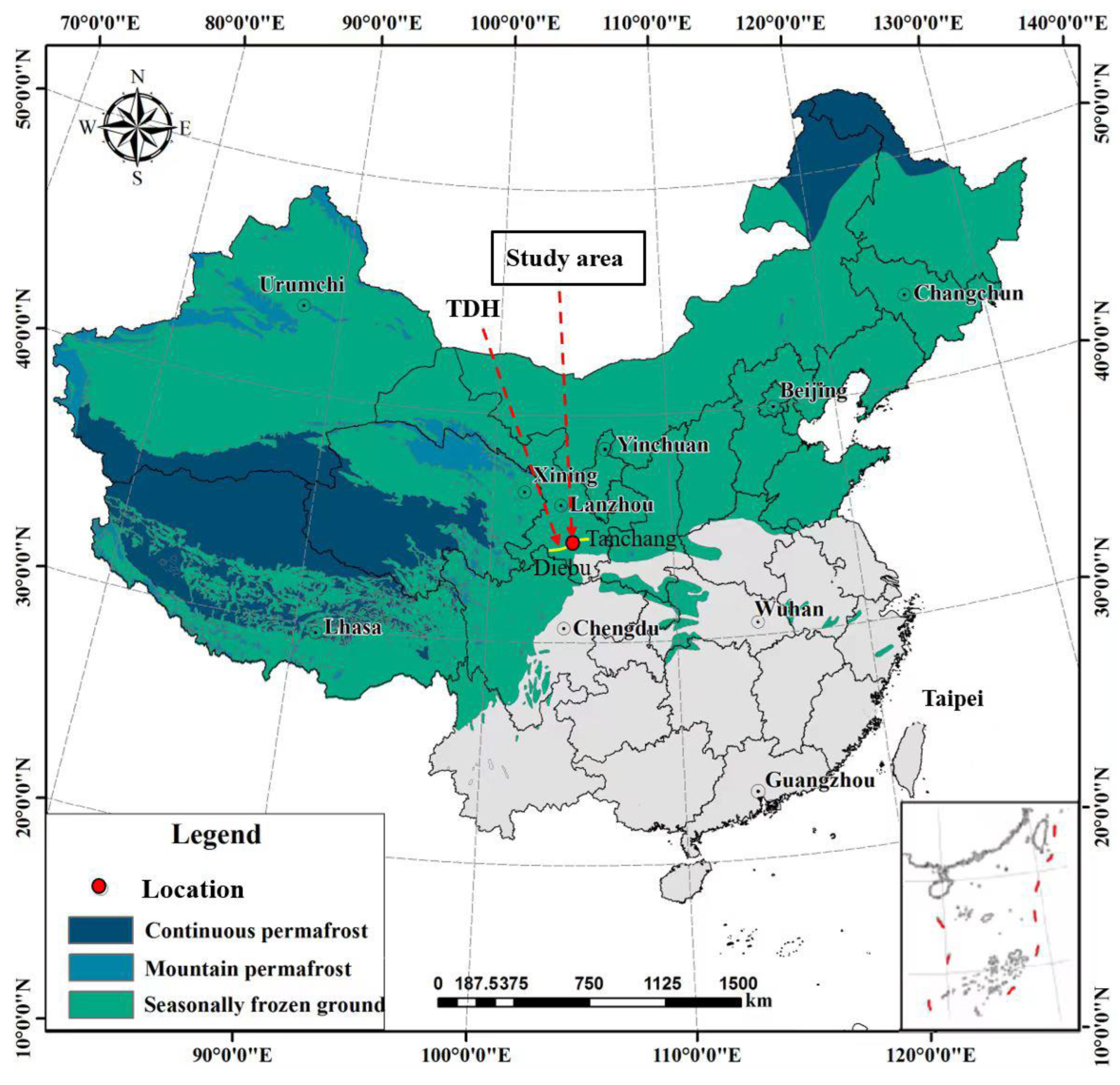
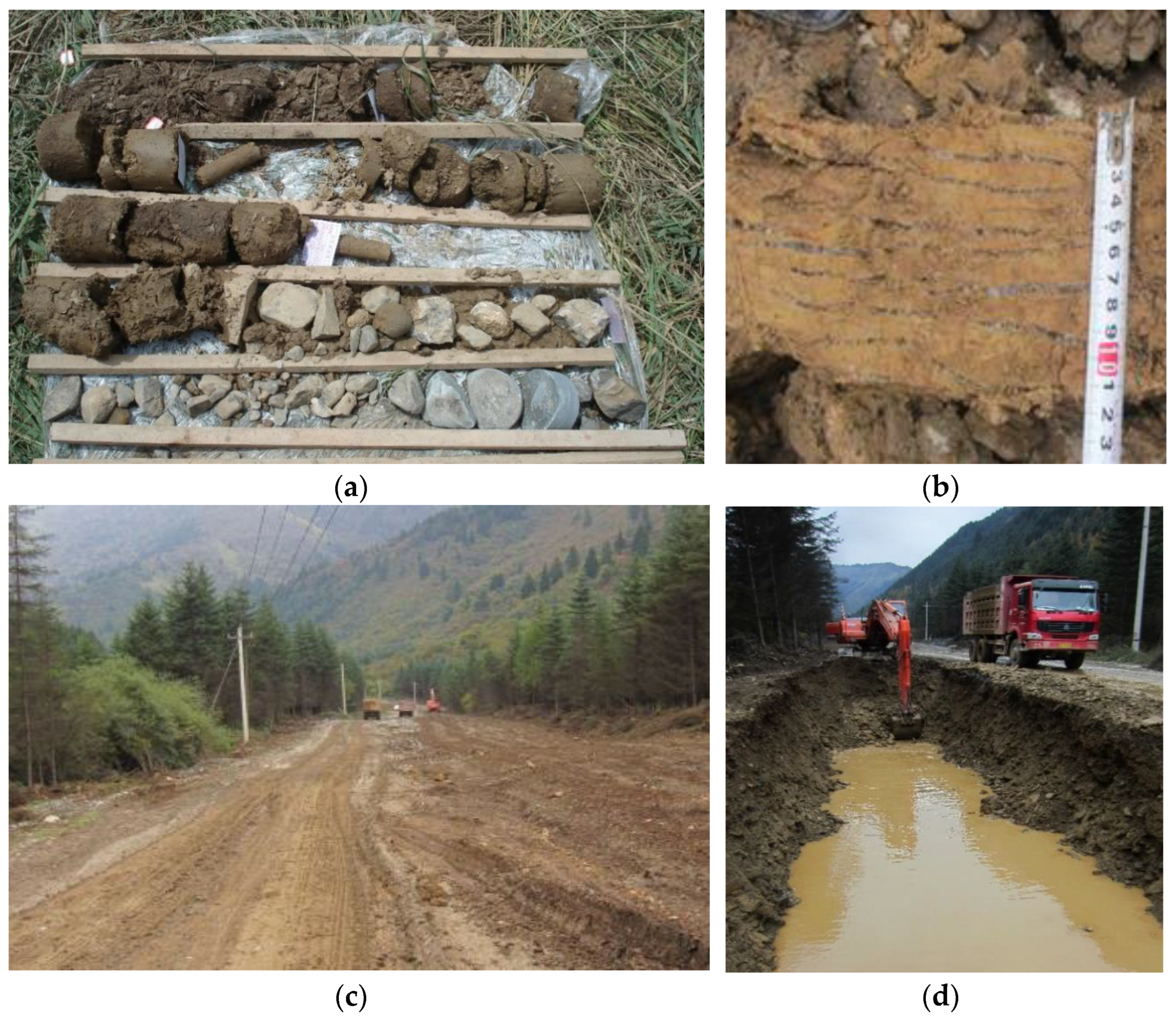
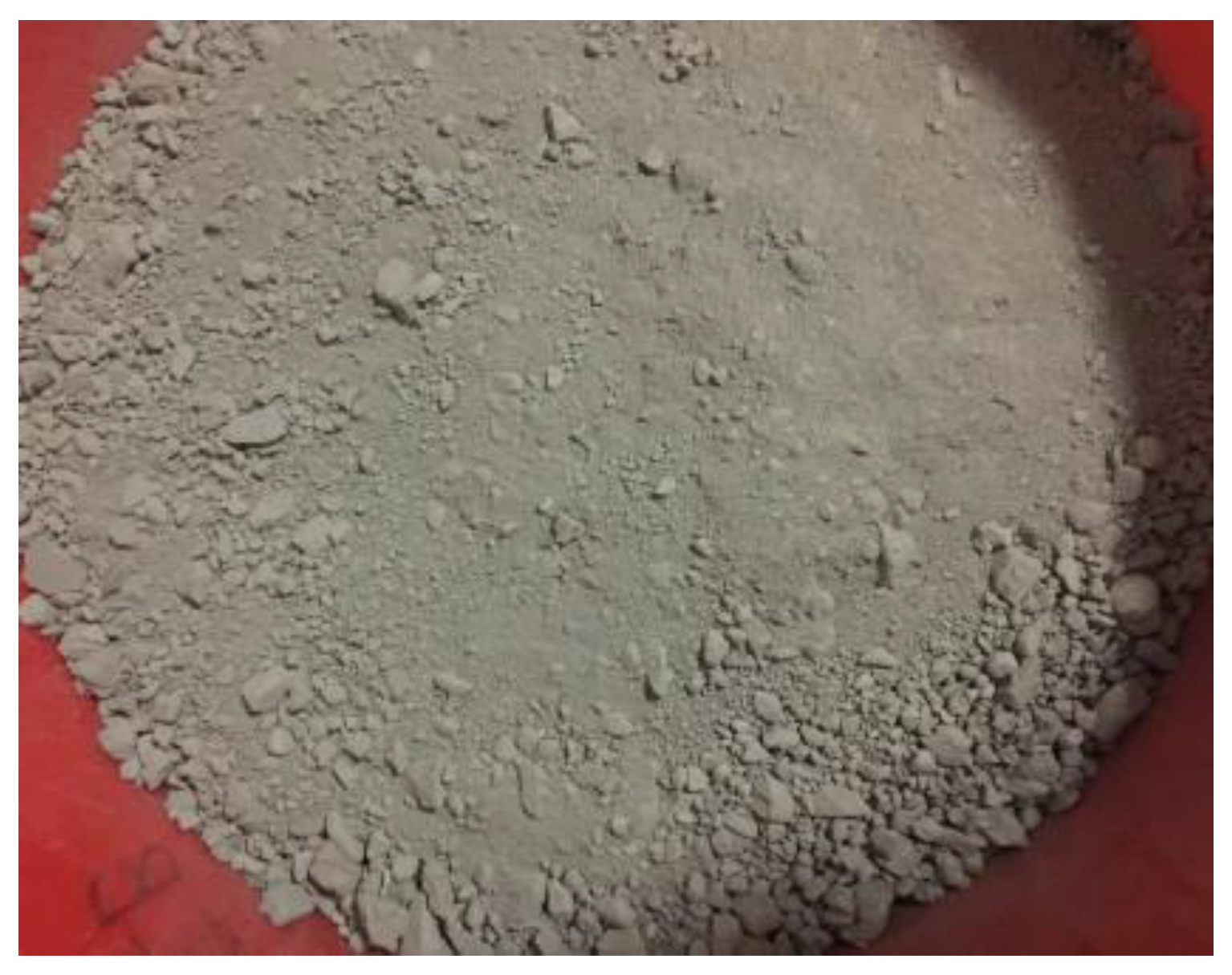

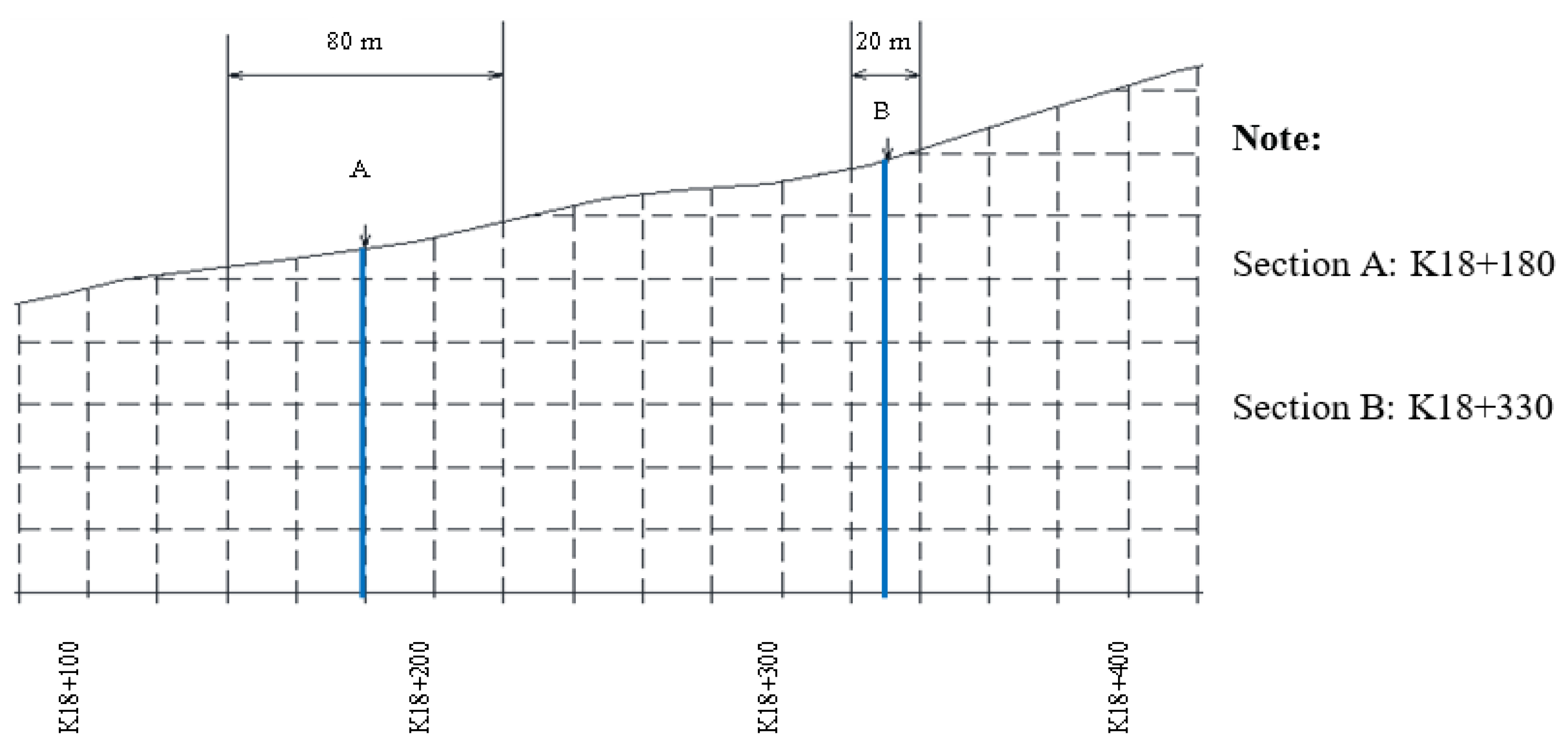


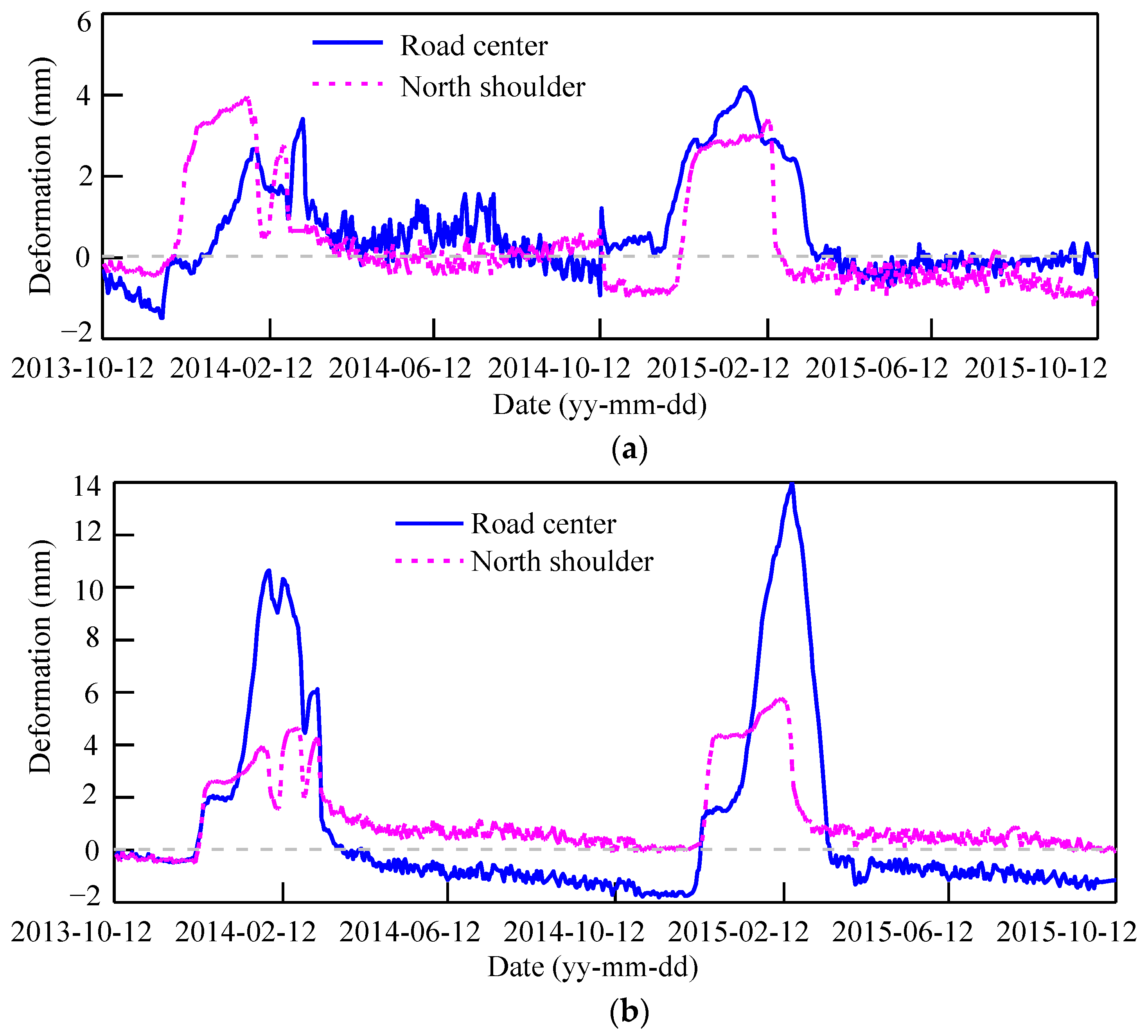
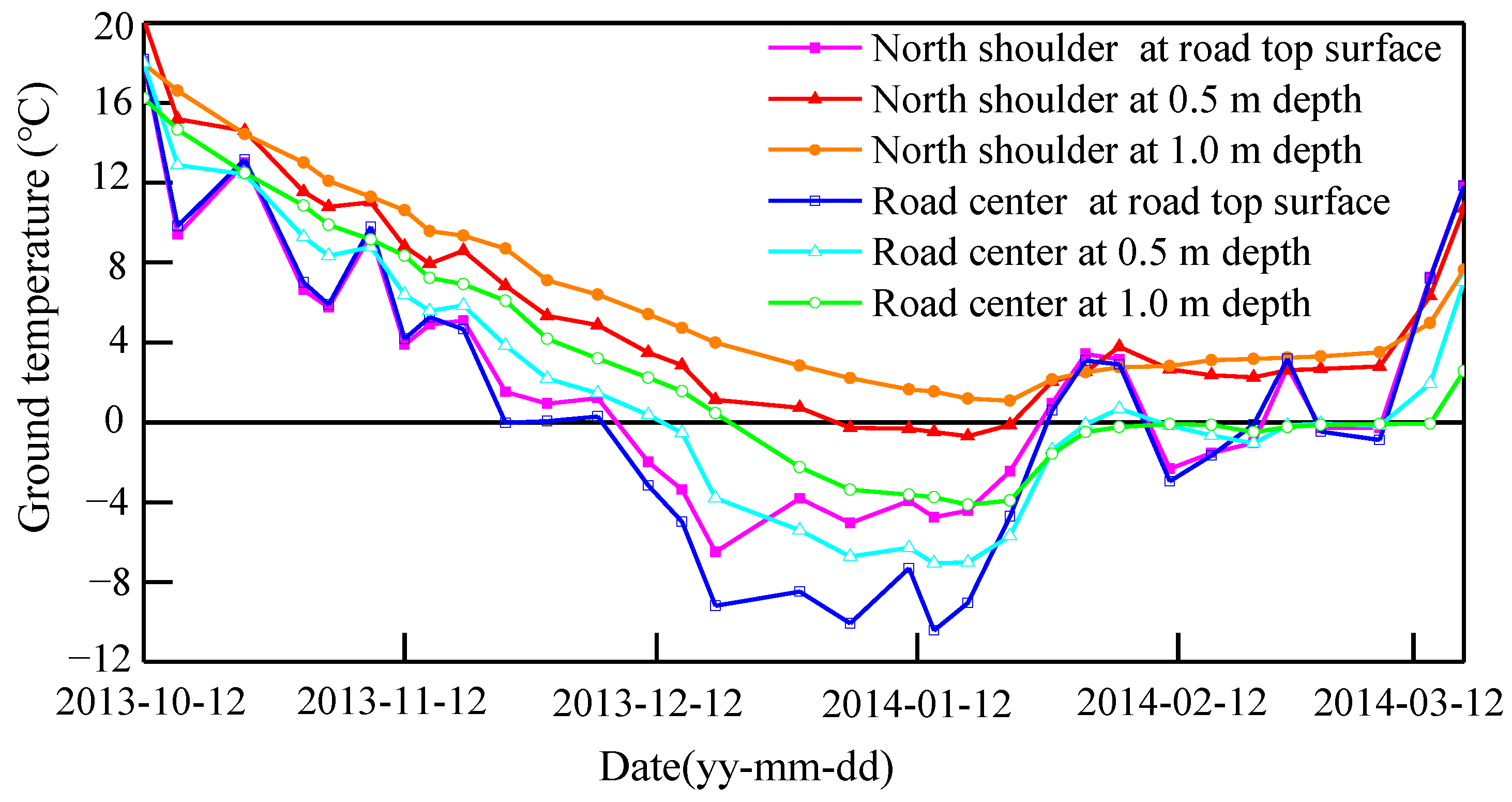



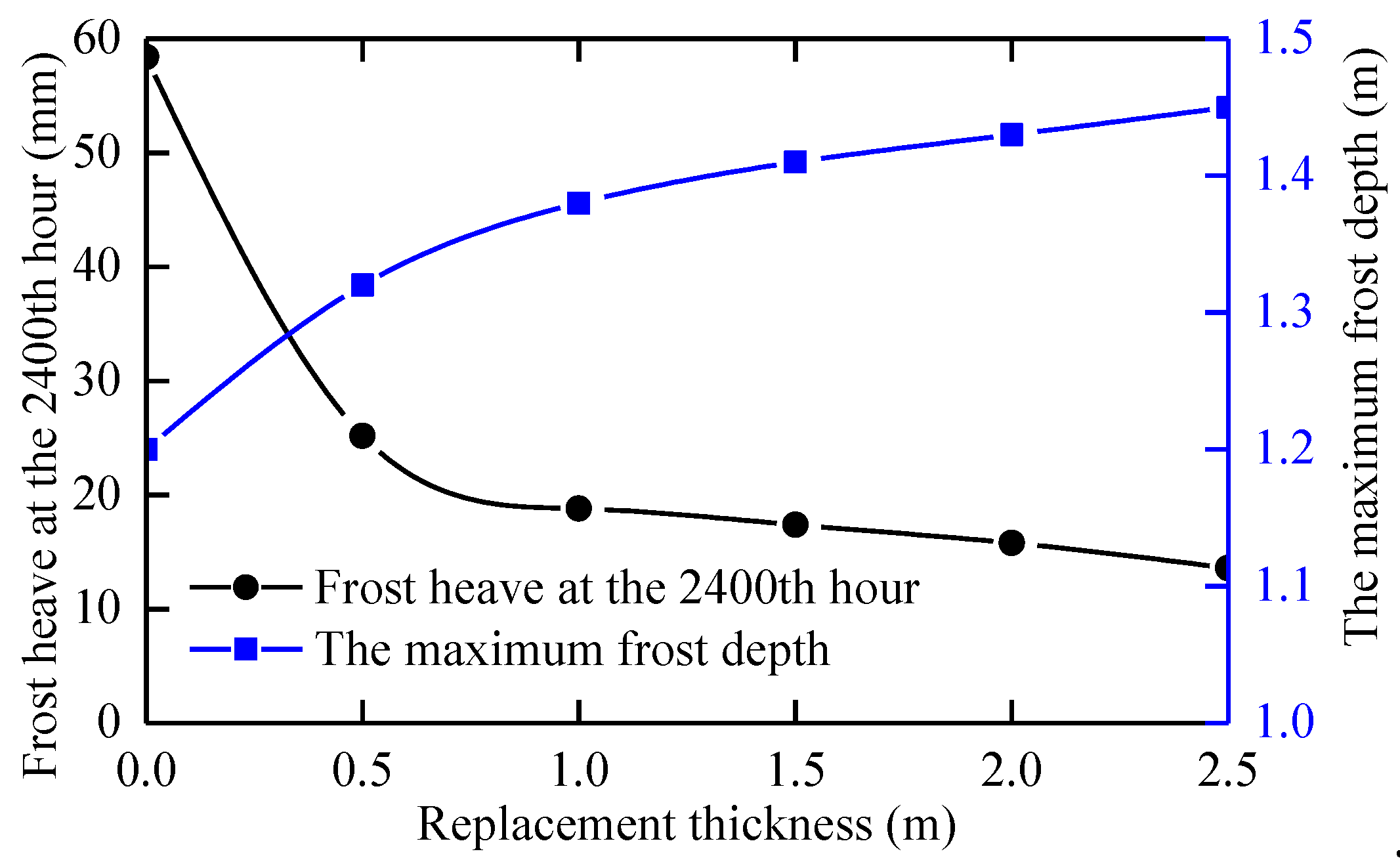
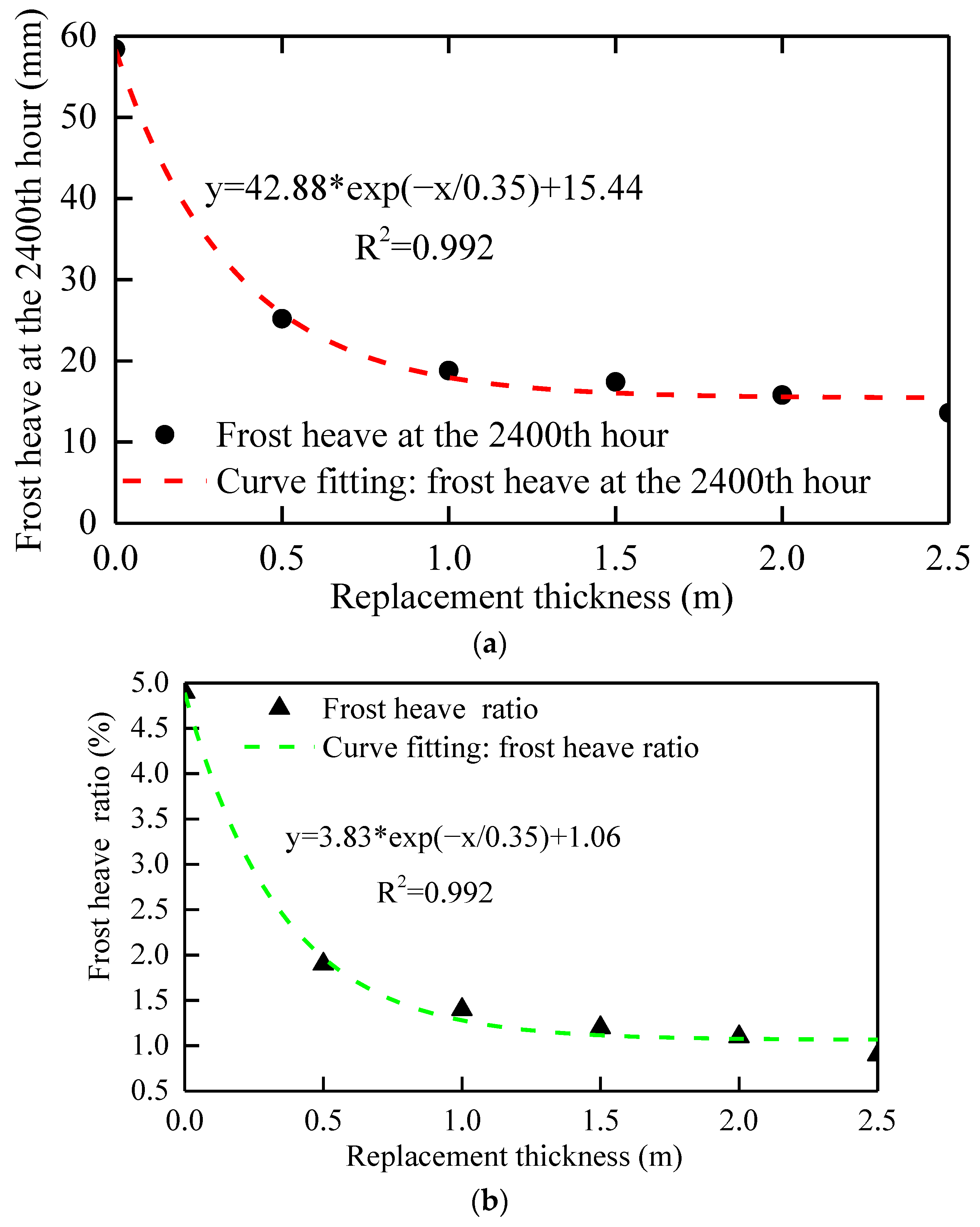
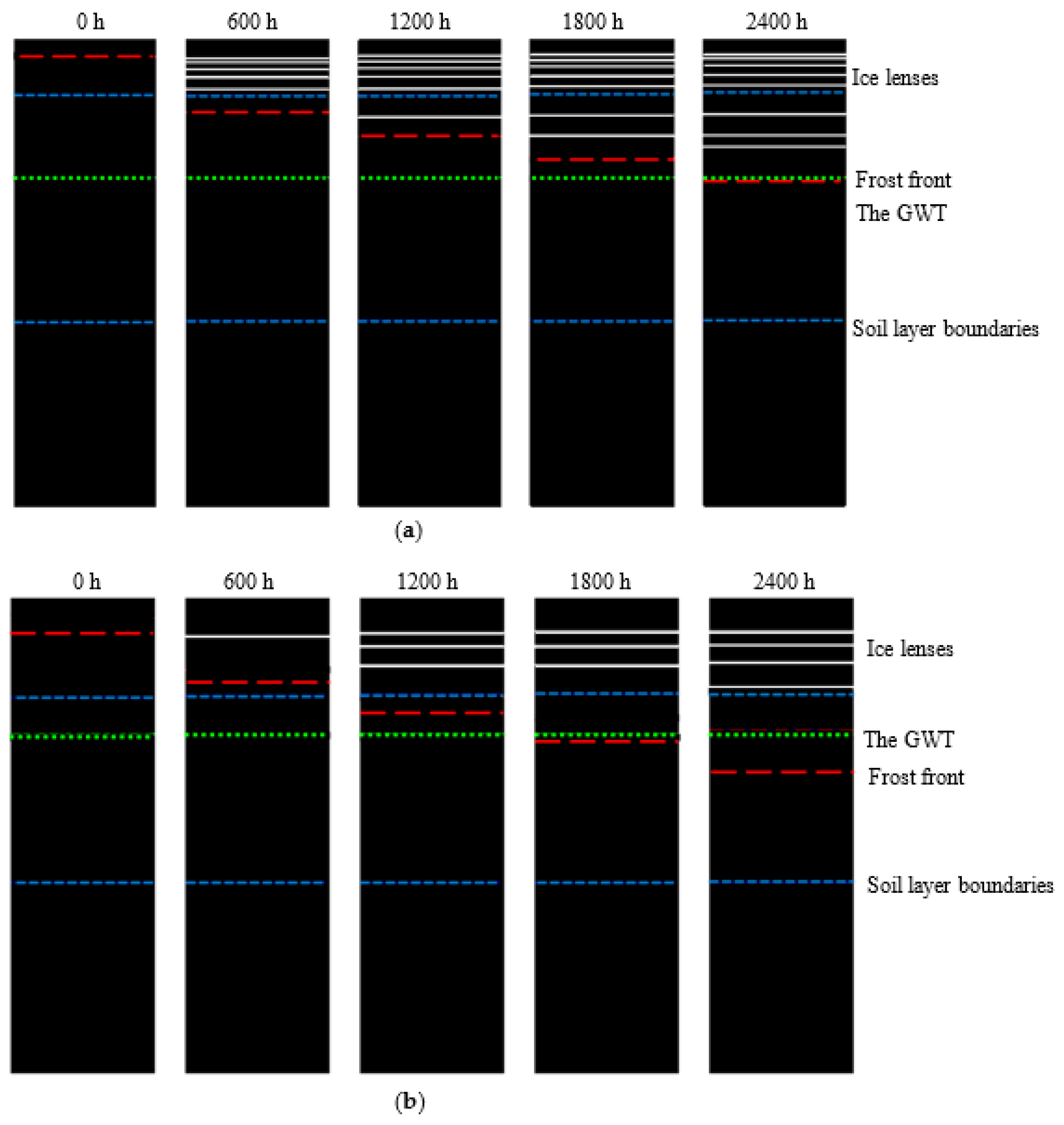
| Climatic Conditions | Value of Number |
|---|---|
| Extreme maximum temperature/°C | 27.9 |
| Extreme minimum temperature/°C | −19.7 |
| The highest average monthly air temperature/°C | 15.2 |
| The lowest average monthly air temperature/°C | −11.2 |
| The mean annual air temperature/°C | 5.2 |
| Mean annual precipitation/mm | 636–718 |
| The Depth of Soil Samples/m | Natural Void Ratio | Natural Water Content/% | Liquid Limit/% | Plastic Limit/% |
|---|---|---|---|---|
| 0.5–1.0 m | 1.13 | 43.5 | 41.0 | 29.0 |
| 1.0–1.6 m | 1.05 | 48.6 | 43.5 | 30.5 |
| Sample Number | Initial Water Content, w/% | Soil Type | Water Supply System | Dry Density, ρd (g/cm3) | Controlled Temperature/°C | |
|---|---|---|---|---|---|---|
| Cold Side | Warm Side | |||||
| N1 | 28 | Silty clay | In a closed system | 1.6 | −15 | +2 |
| N2 | 28 | Silty clay | In an open system | 1.6 | −15 | +2 |
| C1 | 12 | Coarse gravel | In a closed system | 2.0 | −15 | +2 |
| C2 | 12 | Coarse gravel | In an open system | 2.0 | −15 | +2 |
| C3 | 5.8 | Coarse gravel | In an open system | 2.0 | −15 | +2 |
| Soil Parameters | Coarse Fill | Humus Soil | Silty Clay | Gravelly Clay |
|---|---|---|---|---|
| Thermal conductivity of soil solids, λ (W/m·K) | 3 | 2 | 3 | 3 |
| Thermal conductivity of soil solids in the frozen states, λf (W/m·K) | 1.92 | 1.6 | 1.72 | 1.75 |
| Initial gravimetric water content, (%) | 3 | 29 | 30 | 15 |
| Dry density, (kg/m3) | 2.07 | 1.51 | 1.71 | 1.75 |
| Initial degree of saturation, (%) | 70 | 80 | 100 | 100 |
| Saturated permeability, Ksat (m/s) | 3.5 × 10−4 | 1.67 × 10−9 | 3.4 × 10−10 | 1.6 × 10−9 |
| The unfrozen water content at −1 °C, (%) | 10 | 15 | 30 | 20 |
| Test Section | Location | The First Natural Freezing Period | The Second Natural Freezing Period |
|---|---|---|---|
| The Maximum Frost-Heave Deformation/mm | The Maximum Frost-Heave Deformation/mm | ||
| Section A | South shoulder | 4.30 | - |
| Road center | 3.80 | 4.20 | |
| North shoulder | 4.00 | 3.40 | |
| Difference value * | −0.20 | 0.80 | |
| Section B | South shoulder | - | - |
| Road center | 10.70 | 14.00 | |
| North shoulder | 4.60 | 5.80 | |
| Difference value * | 6.10 | 8.20 | |
| Natural field | - | - |
| Filling Depth/m | Computed Frost Heave at 2400 h/mm | Investigated Frost-Heave Value/mm | The Original GWT/m |
|---|---|---|---|
| 0 | 58.4 | 62.0 | 3.4 |
| 1 | 18.8 | 14.0 | 3.4 |
| Filling Depth/m | Computed Frost Heave at 2400 h/mm | Maximum Frozen Depth/m | Frost Heave Ratio/% |
|---|---|---|---|
| 0 | 58.4 | 1.20 | 4.9 |
| 0.5 | 25.2 | 1.32 | 1.9 |
| 1.0 | 18.8 | 1.38 | 1.4 |
| 1.5 | 17.4 | 1.41 | 1.2 |
| 2.0 | 15.8 | 1.43 | 1.1 |
| 2.5 | 13.6 | 1.45 | 0.9 |
Disclaimer/Publisher’s Note: The statements, opinions and data contained in all publications are solely those of the individual author(s) and contributor(s) and not of MDPI and/or the editor(s). MDPI and/or the editor(s) disclaim responsibility for any injury to people or property resulting from any ideas, methods, instructions or products referred to in the content. |
© 2023 by the authors. Licensee MDPI, Basel, Switzerland. This article is an open access article distributed under the terms and conditions of the Creative Commons Attribution (CC BY) license (https://creativecommons.org/licenses/by/4.0/).
Share and Cite
Wu, L.; Niu, F.; Lin, Z.; Shang, Y.; Nimbalkar, S.; Sheng, D. Experimental and Numerical Analyses on the Frost Heave Deformation of Reclaimed Gravel from a Tunnel Excavation as a Structural Fill in Cold Mountainous Regions. Sustainability 2023, 15, 13397. https://doi.org/10.3390/su151813397
Wu L, Niu F, Lin Z, Shang Y, Nimbalkar S, Sheng D. Experimental and Numerical Analyses on the Frost Heave Deformation of Reclaimed Gravel from a Tunnel Excavation as a Structural Fill in Cold Mountainous Regions. Sustainability. 2023; 15(18):13397. https://doi.org/10.3390/su151813397
Chicago/Turabian StyleWu, Libo, Fujun Niu, Zhanju Lin, Yunhu Shang, Sanjay Nimbalkar, and Daichao Sheng. 2023. "Experimental and Numerical Analyses on the Frost Heave Deformation of Reclaimed Gravel from a Tunnel Excavation as a Structural Fill in Cold Mountainous Regions" Sustainability 15, no. 18: 13397. https://doi.org/10.3390/su151813397
APA StyleWu, L., Niu, F., Lin, Z., Shang, Y., Nimbalkar, S., & Sheng, D. (2023). Experimental and Numerical Analyses on the Frost Heave Deformation of Reclaimed Gravel from a Tunnel Excavation as a Structural Fill in Cold Mountainous Regions. Sustainability, 15(18), 13397. https://doi.org/10.3390/su151813397







